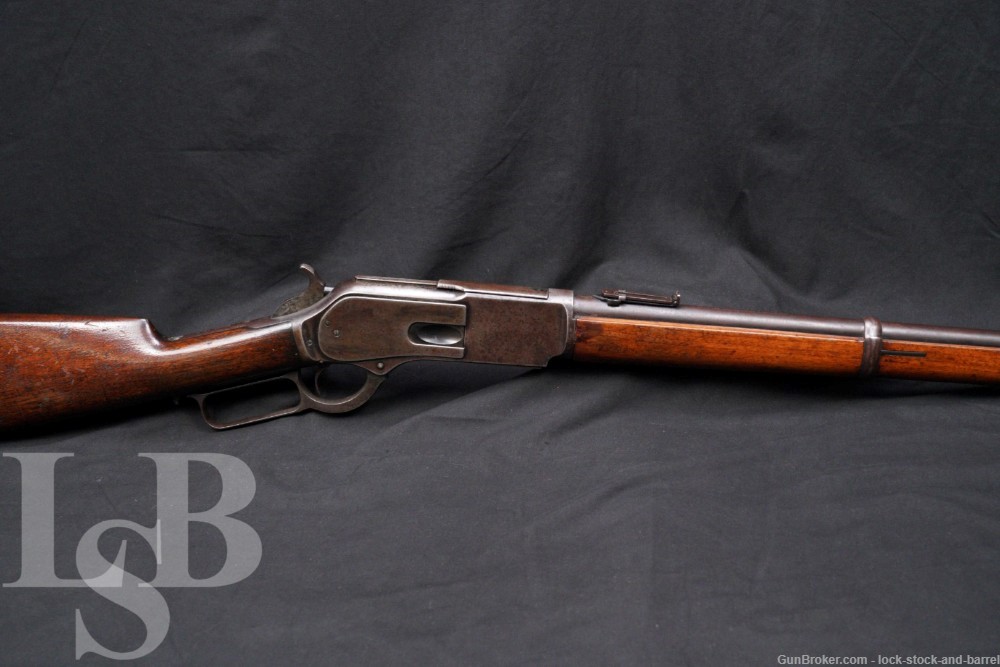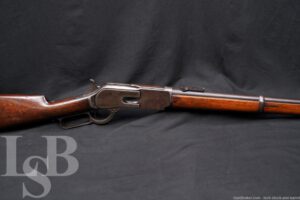
Winchester Model 1876 Centennial Carbine .45-60 Lever Rifle, 1881 Antique
SOLD FOR: $2,675
LSB#: 231025BC044
Make: Winchester
Model: 1876 Carbine
Serial Number: 21196
Year of Manufacture: 1881
Caliber: .45-60 Winchester Center Fire
Action Type: Lever Action with Full-Length Tubular Magazine
Barrel Length: 22″, Round
Sights / Optics: The front sight is a barleycorn-style post fixed to the front of the barrel. The rear sight is a folding ladder-style sight, presenting a “V”-notch when down and having a “V”-notched slider on the ladder arm, marked from 2-10 in hundreds of yards. The rear sight is dovetailed to the barrel and folds up away from the user, typical of folding ladder sights which were installed on carbines with a dovetail at the rear of the barrel. The top tang is drilled, tapped and filled for a tang sight (none present).
Stock Configuration & Condition: The stocks are two-piece smooth walnut. The forend is a carbine-style, which for the Model 1876 is a nearly full-length forend, with a spring-clip secured barrel band and a steel nosecap. The buttstock has a straight grip, straight comb and steel carbine-style buttplate. The forend has a long crack at the right-front and a filled loss at the right-rear. The buttstock has a filled chip in the comb in front of the buttplate’s tang. There are scattered nicks, scuffs and scratches with a few more notable dings in the buttstock. There is no obvious sign of sanding, but it does appear that a new finish has been applied. The forend has very minor play front-to-rear, typical of the 1876 Carbine forend. The LOP measures 13” from the front of the trigger to the back of the buttplate. The buttplate has mostly gone to a moderate patina with some areas worn and some surface erosion. The stocks are in Good-Very Good overall condition as refinished Antique.
Type of Finish: Blue
Finish Originality: Original
Bore Condition: The bore is gray with well defined rifling. There scattered light erosion and pitting in the bore. In this writer’s opinion, this bore rates 5 or 6 out of 10.
Most antique firearms have bores that will show erosion. This is not only due to age but to the use of black powder. When fired, black powder reacts corrosively. NRA Antique Firearm Conditions Standards are quite lenient for bores. In some cases the NRA standards disregarded the bore’s condition for collectors firearms.
Overall Condition: This rifle retains about 15% of its metal finish. Finish remains in protected areas and around raised features. Most exposed surfaces have gone to a fairly uniform light patina with most edges worn to white. There are some scattered spots of light surface oxidation and infrequent minor erosion. There are scattered light nicks, scuffs and scratches with wear on the left of the receiver from the saddle ring. There is a cluster of nicks on the bottom of the lifter. The action shows operational wear. The screw heads range from sharp to tool marked with usable slots. The markings range from clear to worn, but legible. Overall, this rifle is in Very Good condition as Antique.
Mechanics: The action functions correctly. The hammer has a half-cock safety position and there is a lever safety. Typical of the 2nd Model, the rail for the dust-cover is secured to the frame via screws. We have not fired this rifle. As with all used firearms, a thorough cleaning may be necessary to meet your maintenance standards.
Box, Paperwork & Accessories: None.
Our Assessment: The Winchester Model 1876 was a heavier-framed rifle than the Model 1873, and was the first to be chambered for full-powered centerfire rifle cartridges, as opposed to rimfire cartridges or handgun-sized centerfire rounds. While similar in design to the 1873, the 1876 was actually based on the prototype 1868 lever-action rifle that was never commercially produced by Winchester. It was introduced to celebrate the American Centennial, and earned a reputation as a durable and powerful hunting rifle that was also used by the Canadian North-West Mounted Police and the Texas Rangers. Theodore Roosevelt used one on his early hunting expeditions in the West and one was found in the possession of Apache warrior Geronimo after his surrender in 1882. Unfortunately, the 1876 lost popularity when the Model 1886 was introduced in heavier calibers.
This example is a 2nd Model Carbine made in 1881. Perhaps counter-intuitive, the 1876 Carbine had a nearly full-length forend with a barrel band and nosecap. The barrel is chambered in .45-60 Winchester Center Fire, a cartridge designed for the short action Model 1876 rifle, having a slightly smaller, straighter case than the original .45-75 cartridge.
This 1876 Carbine is in Very Good condition as Antique. The rifle shows its age, but retains strong mechanics, a decent bore and some of its original blue finish. The 1876 Winchester was only made for 21 years, with a total of about 63,871 made in rifle, carbine and musket formats, with the result that ALL are collectable. This would be a great rifle to add to a collection, placed between an 1873 and an 1886. Please see our photos and good luck!
Please forgive any typos, I was educated in California. -Bud

